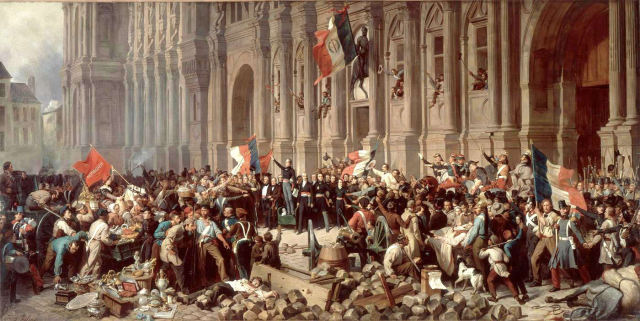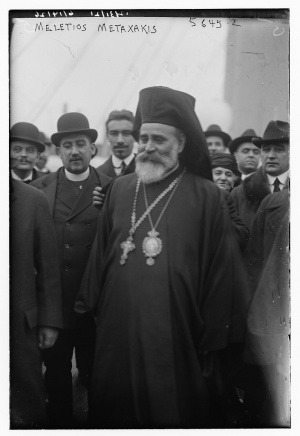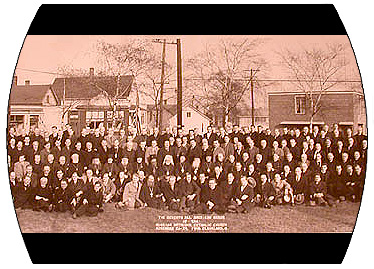“The OCA … are officially against Freemasonry (one is not allowed to be both a Mason and Orthodox Christian) but it is widespread in many of the OCA’s old-line parishes, especially on the East Coast” of America (Orthodox Jurisdictions in America).
“So come on people,” you might say, “What’s the problem here? You are so up tight.”
Here are the principles involved:
1. Masonry, at its core, is Luciferic and anti-Christian. It is not just non-Christian, but is anti-Christian and is waging a covert war against Christianity. Masons will deny this, of course, and many won’t even know it. But it is the case, according to the Church.
2. It was for this reason that the Church declared that no Christian can also be a Mason, and even more so that no priest or bishop can be allowed to be a Mason and continue in his church office because he is in heresy.
3. Many of the modernist Orthodox churches have ruling bishops, metropolitans or even patriarchs who are practicing Masons. At this level of office these men are responsible to know what Freemasonry is and that it must not be allowed in their synods. Yet these synods know of these practices but have done nothing.
4. The synods that knowingly allow Masons to continue as conciliar bishops in their midst are by this act placing themselves in rebellion against the Church canons. They have made themselves also into heretics by accepting and con-celebrating with heretics (Masonic priests).
5. The grace in the sacraments of the Christian church descends through its hierarchical offices. When the hierarchy is in heresy (this differs from mere immorality) the Christian must cut it off. Putting this another way, the Christian gospel teaches that we are not to pray together with heretics and therefore the Church canons require this also. The local parish must therefore not con-celebrate heretical hierarchs.
Let us see what relationship Masonry might have to modern Orthodoxy. According to the priest, Andrew Phillips, in his Freemasonry, Renovationism, and the Psychology of Modernism:
Historically, freemasonry has aggressively promoted itself, particularly against Roman Catholicism and the Orthodox Church. This is because it sees them as traditions which frustrate its attempts to create conditions for world unification under its ideology. Thus, in the eighteenth century masons brought about the satanic French Revolution of 1789, which transferred power from the Roman Catholic aristocracy to the ever-greedy and masonically-led bourgeoisie. Many famous people in the France and the Western Europe of the time were freemasons, including Voltaire, Diderot and Mozart.

French Revolution, Image credit – theimaginativeconservative.org
Freemasonry first entered Russia during the wave of enforced Westernisation in the 18th century, under figures like Schwarz, Lopukhin and the journalist Novikov (1744-1818). … Freemasonry then became instrumental in the Decembrist revolt of 1825 in Russia … Freemasonry went on to become very influential among the Russian ruling class, many of whom lost their faith. Most Russian newspapers before 1917 were under its control, until it engendered the first satanic (and masonic) Russian ‘Revolution’ of 1917. Unfortunately for the freemasons, they lost control of their movement to a group of opportunists, the Bolsheviks, who brought about the second satanic ‘October Revolution’, which proved to be anti-masonic. …
Next we move to Cyprus, before the First World War, where we find an Orthodox bishop becoming a Freemason. This would be completely insignificant, but the story doesn’t begin or end there.
By the beginning of the 20th century, freemasonry was being promoted by the commercial conquests of the British Empire and masonic lodges were opened worldwide. This included in Orthodox areas like Cyprus and the Middle East. It was in Cyprus before the First World War that an Orthodox bishop became a freemason. (Freemasonry, Renovationism, and the Psychology of Modernism)
This bishop became the Patriarch Meletios of Constantinople (in Turkey) who forced the new calendar upon the Orthodox in the 1920s. The Patriarch became notorious for his power plays among the Russian Orthodox emigres of France and North America, and for taking over former Russian Orthodox territories in Finland and Estonia, and for attempting the same in Poland and Czechoslovakia.
 He sided with the Communist (Bolshevik) approved supposedly Orthodox modernists in Russia, called renovationists, against His Holiness Patriarch Tikhon of Moscow. The renovationists were Masonic in temper, and Patriarch Tikhon was soon martyred by the Communists for resisting their corruption of the Faith. Thus, according Pillips, “having brought about the collapse of the Russian Empire in 1917, which it had been infiltrating for some 200 years, freemasonry left Russia to Soviet and later Nazi satanists.” These events clearly place Meletios on the wrong side of things.
He sided with the Communist (Bolshevik) approved supposedly Orthodox modernists in Russia, called renovationists, against His Holiness Patriarch Tikhon of Moscow. The renovationists were Masonic in temper, and Patriarch Tikhon was soon martyred by the Communists for resisting their corruption of the Faith. Thus, according Pillips, “having brought about the collapse of the Russian Empire in 1917, which it had been infiltrating for some 200 years, freemasonry left Russia to Soviet and later Nazi satanists.” These events clearly place Meletios on the wrong side of things.
The history that Phillips outlines next should be of particular interest to Westerners. In the 1920s, three dozen or so Russian bishops, who were shepherding Russian flocks that had emigrated from Russia due to the revolution, met in Constantinople and formed the “Russian Synod,” or as some call it, the Russian Orthodox Church Outside of Russia (ROCOR – also called “the Church Abroad”, below), under the protection of the Patriarch of Serbia (instead of Meletios). They rejected the new calendar of Meletios and set up an ecclesiastical headquarters in Paris. Meletios, however, was able to engender a Masonic/Orthodox movement among some in Paris and incite them to split off from the ROCOR bishops. Pillips continues:
He found particularly easy prey in Paris among the many masonic Russian aristocrats and wealthier emigres who had emigrated there after 1917 (5). Since freemasonry had become very popular in St Petersburg before the Revolution, together with other pseudo-mystical movements such as spiritualism, Hinduism, Buddhism etc, the emigres took their vain beliefs into the emigration with them. There, Patriarch Meletios’ supporters managed to engineer a schism from the Church of the Russian Emigration, a schism that was to be repeated later in North America. It should be noted that the Church of Greece strongly opposed Patriarch Meletios and in the 1930s firmly condemned freemasonry, in the same way as the Russian Orthodox Church Outside Russia. (Freemasonry, Renovationism, and the Psychology of Modernism)
By the early 1920s, ROCOR had become, independently of the USSR, the synod of pretty much all Russian Orthodox outside of Russia. In 1923 in America ROCOR placed Metropolitan Platon as head of the diocese. However the following year, “under pressure from the Soviet authorities, the Patriarch (Tikhon) rescinded this appointment and even recalled Metropolitan Platon to Moscow to submit to an ecclesiastical court (A Brief History of the Russian Orthodox Church Outside of Russia, by Protopriest Sergii Shchukin).”
At this point the ROCOR entered into turmoil. Certain American bishops – part of a “living church” movement – saw the opportunity to become independent of both Moscow and ROCOR and formed the American Diocese at a synod in Detroit, attempting to elect Metropolitan Platon as its head. Platon refused, but this seems to be because he wanted autonomous authority over all Russian churches in America. ROCOR, which was under the headship of the Serbian bishop, refused this.
Therefore the Serbian Synod sent Archbishop Apollinarii to North America to head the parishes that remained faithful to the ROCOR. Platon attempted, without a hearing, to suspend him, but ROCOR seeing this as uncanonical suspended Platon instead and Apollinarii became Metropolitan of the ROCOR in North America. Platon then attempted to establish a new American “Holy Synod of the American Orthodox Catholic Church.”
Nothing came of Platon’s new church, since all the Orthodox churches condemned the move – even the church in Russia. By this time in Russia, Patriarch Tikhon had died (some say poisoned), and had been replaced by Metropolitan Sergius. The ROCOR synod regarded Sergius as an uncanonical puppet of the Russian atheistic communists and would have none of his authority. But even Sergius rejected this move by Platon, in a ukase in 1933. Platon died the following year, but the “living church” in America carried on. They proceeded to elevate bishop Theophilus Pashkovsky to the rank of “Metropolitan of All America and Canada (A Brief History of the Russian Orthodox Church Outside of Russia).”
This new American synod, realizing they were on thin ice, proceeded to acknowledge the authority of the Synod of Bishops in Serbia (ROCOR / the Church Abroad). Councils ensued, and, “the Synod of Bishops accepted them into the Church Abroad as a Metropoliate. Metropolitan Theophilus took part in the composition of the Regulations of the American Church at a conference in Yugoslavia presided over by the Serbian Patriarch Varnava. This unity with the Church Abroad continued until 1946.”

7th American Sobor, Image credit – oca.org
In 1946 the American Metropoliate expressed its allegiance with the Sergianist church in Russia by recognizing the Patriarchate of Moscow, which as we saw above, ROCOR did not recognize. Thus the Metropoliate split from ROCOR; but when they were not able to accept the terms that Moscow required, they went on their own. About half of the bishops in the Metropoliate went along with this decision, and half left this synod and returned to ROCOR.
The American Metropoliate would eventually become the Orthodox Church in America (OCA), but this did not occur until 1967. If one understands that secular Western thought is rooted in the mysteries that illuminized Masonry espouses, then the nature of the OCA becomes clear in the following quote. This is from the preface of The Northern Thebaid, published by the monks of the Fr. Herman Brotherhood monastery in Colorado. There, Fr. Seraphim writes:
Every Orthodox Christian should know the Lives of the Fathers of the desert … . Every Orthodox Christian should be inspired by their life of struggle far from the ways of the world. There is no “romanticism ” here. The actual “romantics” of our times are the reformers of “Parisian Orthodoxy” [the Masonic-leaning group under Meletios] who … wish to “sanctify the world,” [by replacing] the authentic orthodox world view with a this-worldly counterfeit of it based on modern Western thought. (As quoted in Not of this World, by Monk Damascene Christensen, 1993 2d edition, titled, “Renovationism” p.474,475)
He was referring to a, “new breed of scholars” that had taken root in America, derived, he says,
from the so-called ‘Parisian’ school of Orthodox thought, composed mostly of members of the Russian intelligentsia. While in Russia, some of these people had helped pave the way for the Revolution. [But] seeing the horrors this would bring, they had repented … fled the country [and] formed an emigre community in Paris, and in their philosophy attempted to return to their cultural and religious heritage. When they came to Orthodoxy, however, it was largely to an Orthodoxy of their own devising. They looked down their noses at the ‘popular piety’ of the ‘masses,’ which they felt they had to refine … . (Ibid. p.465)
This “Parisian school” of intelligentsia derived from the same group that the Masonic Patriarch Meletios of Constantinople found to be such a fruitful field for his modernist schism. The priest, Phillips, gives evidence of this continuity:
Thus, in Paris, two churches under the Constantinople jurisdiction were, to my knowledge, being used for masonic initiations in the 1970s and 1980s. As for the Russian cemetery at St Genevieve des Bois, many gravestones are decorated with the compasses, the masonic emblem. In one church parishioners openly gave each other masonic handshakes. However, it should not be thought all male members of the Paris Jurisdiction were or are masons. It is simply that many of the key ones were at the time, and others simply went along with the movement (6). (Freemasonry, Renovationism, and the Psychology of Modernism)
It was from among these ranks in the 1950s, says Christensen, that,
Fr. Schmemann came to New York from Paris in 1951, and very soon became the unrivaled idealogue of the American Metropolia (now OCA). … Like his predecessors, he was critical of ‘old-fashioned piety,’ particularly that of the pre-Revolutionary Russia. He believed this ‘piety’ … was the result of unfortunate ‘cultural accretions’ which had to be reevaluated and stripped off in layers by modern scholars. … He spoke of finding ‘new ways of Orthodox theology,’ of intellectually ‘mastering history’ and thus ‘restoring’ Orthodoxy to … its pure form.” (Ibid. p.465)
Restoring Orthodoxy to its pure form may be all well and good, but one does not want the effort to be led by a man who lacks the discernment to see the Masonic anti-Christian influence in the OCA, to call it out, and to separate himself from it. He does not want to correct modernist distortions. but rather it is the “old-fashioned piety” that he sees as the problem.
Since the ROCOR church in America has now been effectively destroyed and/or subsumed into the American Metropolia (OCA), we have come full circle, from the Masonic takeover of the Orthodox Church in Constantinople represented by Meletios, to the current stream of crypto-Masonic thought in the OCA. The destruction of the Orthodox Church in America is complete, but for a few tiny groups such as GOCA.
See also:
- EASTERN ORTHODOX FREEMASONS
- The Renovationist Heresy
- Russia, the Turks, and Rome
- Gog’s Theosophical Empire of the End: Russia!
And Masons in Orthodoxy:


